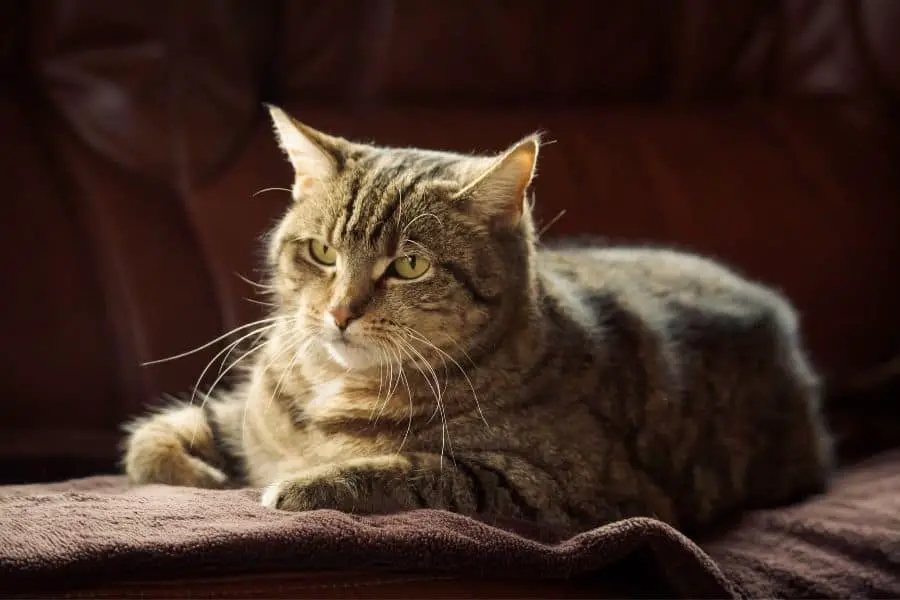More Meows is an Amazon Associate. As an Amazon Associate we earn from qualifying purchases. We may also earn commissions if you purchase products from other retailers after clicking on a link from our site.
Choosing to adopt a cat is a careful commitment, and some cat owners worry that female cats may be harder to take care of than male cats. But, whether you’re adopting a kitten or an older cat, there are things to know about and behaviors to expect from female cats.
No, spayed female cats are not harder to take care of than neutered male cats. Other factors that play a larger role than gender in determining a cat’s personality are cat breed, how humans raise the cat, and past trauma.
Keep reading to find out the critical differences in male and female cats, get insight into caring forboth spayed/unspayed female cats, and learn what it takes to adopt a female cat.
If you wonder what the best products are for your cat, check out this article that will break down all my recommendations for you: Things To Buy For A Cat Right Now!
Differences in Male and Female Cats
The expected behaviors for both male and female cats can significantly depend on the pet’s age, whether they are spayed/neutered, and any past trauma they may have gone through.
Here are some key differences between the genders of cats to think about when adopting one:
| Male Vs. Female Cats | Characteristics |
| Unneutered Male Cats | – Tend to roam more – Likely to mark territory (spray) – Do better with other male cats – Will rival other cats if threatened |
| Neutered Male Cats | – Tend to be more affectionate – Will mark (spray) when threatened – Creates deep bonds with other cats – Lives well alongside both sexes |
| Unspayed Female Cats | – Desires affection more often – Tends to roam when in heat – Will mark territory (spray) – Tend to rival other females – Known to be louder vocally |
| Spayed Female Cats | – Tend to be calmer in demeanor – They are typically more self-reliant – Get along better with male cats – Don’t like rough play – Give maternal affection |
Now that you know the difference between caring for fixed and unfixed male and female cats let’s move on to some factors that may cause a cat’s temperament.
Factors in the Temperament of Cats
Many factors can contribute to the temperament of cats.
Some factors that might cause a cat to be either calm or rowdy include:
- Race
- Sterilization
- Past Trauma
Now, let’s dive deeper into each of these factors below.
Race
The temperament of a cat can primarily be affected by not just their sex but also their race. Some breeds, whether female or male, are known to be more affectionate, such as the American Shorthair or Maine Coon, according to The Cat Fanciers’ Association.
Sterilization
Behaviors of both male and female cats can also vary if they’ve been sterilized and when in life they underwent this change. However, many pet owners claim that unaltered cats can cause lots of frustrations, often act out more, and tend to roam looking for mates.
Keep in mind that if a cat is sterilized deep into adulthood, it may retain many of the behaviors it had before being altered regardless of its new status.
Past Trauma
Caring for an adopted cat from a shelter can be different than caring for a newborn kitten. Depending on what your feline’s past has held, taking care of your cat may mean dealing with a few behavioral issues until your cat adjusts to its new environment.
When adopting, ask for all the information you can on the cat’s history and background. This may help you decide if the cat is suitable for your family.
Caring for Unaltered Female Cats

It may be more challenging to care for a female cat that has not been spayed for many reasons.
Some reasons an unspayed female cat may be harder to take care of include:
- Temperament
- Heat
- Pregnancy
Now, let’s dive deeper into each of these factors below.
Female Cats in Heat
All cats will experience heat, though it’s typically much more intense for those female cats who have not been sterilized. A female cat can begin experiencing a heat cycle as young as four months old. According to Cats International, the length and time of year of a female cat’s heat cycle can depend on geographic location.
For example, in warmer environments, the heat cycle of cats typically starts in late December/early January and will end shortly after the summer solstice. While cats in colder climates may be more likely to experience heat cycles beginning in late January/early February, continuing all through the fall season.
Pregnancy
Taking care of a female cat that has not been sterilized may very well mean taking care of a cat in her transition to motherhood at some point, especially if your cat roams outside or socializes with other males in the area.
Female cats can typically have 2-3 litters per year until they reach an average of 8-9 years of age. Therefore, a female cat who is left with other unneutered male cats regularly could be pregnant for a great majority of her life.
Things to consider about pregnancy in female cats:
- Increased vet bills from ultrasounds and routine maternal care
- Laboring after the gestational period
- A litter of new kittens to care for
- Increased spending on pets if you keep kittens
If you’re looking into adopting a female cat that you plan on keeping unaltered, you may want to consider pet insurance. Pet insurance can help pay for maternal care should your cat become pregnant, along with many other regular pet expenses such as vet visits, prescriptions, and more.
Caring for Spayed Female Cats
Caring for a spayed female cat might be easier than an unspayed cat because this usually calms them down.
Some traits you can see in a spayed female cat that may make them easier to take care of include:
- Love for affection
- Maternal instincts
- Calmer temperament
Now, let’s dive deeper into each of these traits below.
Love for Affection
Most owners of spayed female cats say that the cats become extremely loving and have an increased need for affection after undergoing the surgery. In addition, without such an intense heat cycle, female cats often take on a much calmer demeanor and become more friendly.
The personality of an unspayed female cat can often be territorial and stand-off-ish. However, most families don’t find these personality traits compatible with domestic living, therefore getting your cat spayed may be the best option for your home.
Maternal Instincts
Another interesting part of caring for spayed female cats is that they retain maternal instincts, even after being sterilized. This can be an excellent characteristic, especially if there are kids or other pets in your home.
A female cat will transfer her maternal feelings onto her human caregivers, making for an incredible bond. If another kitten is added to the family, the female cat will likely step up and play the role of mother, looking after the new kitten as well.
Adopting a Female Cat
Here are a few things to keep in mind when adopting a female cat:
- If adopted from a rescue shelter, the feline will most likely be spayed. If not, the shelter may require you to pay for the cat to be spayed before adopting.
- If you already have cats at home, male or female, consider their personalities when choosing a new companion for them.
- Do extensive research on the breed of cat you choose to adopt to be more prepared to deal with any behaviors that present themselves.
- Ask everything you can about the cat’s history, past trauma, vet life, prior owners, etc.
Now that you know what to keep in mind when adopting a female cat let’s learn more about the different places you can adopt cats.
Resources for Adopting Cats
The Cat Adoption Team Organization has a plethora of great information all about adopting cats. They also have videos to watch on transitioning your cat to your home and checklists of supplies to gather when adopting your first feline friend.
The Humane Society has great resources specifically on adopting from an animal shelter or pet rescue group. Their website can also get you connected to local shelters in your area.
ASPCA is another organization that can help you with general cat care, connect you to local shelters, and helps you determine what type of female cat is best for your family.
Are Male or Female Cats More Loving?
Female cats are loving, but I personally don’t think they are more loving than male cats. The truth is the affection your cat shows is more based on its personality, whether it is neutered/spayed, and the specific cat breed. Cat gender does not appear to be a dominant driver of how loving your cat is.
To learn more about if female cats are loving, check out my article: Click Here.
Are Female Cats Less Friendly Than Males?
No, in my opinion, spayed female cats are just as friendly as neutered male cats. There are many articles on the internet claiming that male cats are friendlier, but I personally disagree with this.
Conclusion
No, female cats are not harder to take care of than male cats by any effective means. While there are some differences, pet owners don’t report females to be harder to take care of.
If you liked this article, please check out a few others:
- Do Cats Like Cat Strollers? (The Honest Truth): Click Here.
- Do Cats Like Cat Condos: Click Here.
- Are Female Cats Loving? Revealing Details About Cat Love: Click Here.
